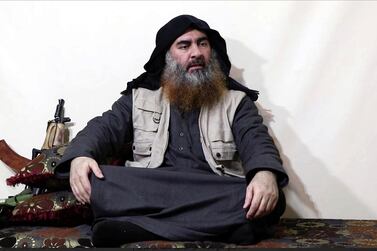Many thought ISIS leader Abu Bakr Al Baghdadi was dead until he resurfaced in an April video to claim Sri Lanka's Easter Sunday attacks. Before this, he had not been seen publicly since 2014.
On Sunday, the latest report of Al Baghdadi's death claimed that US special forces in north-west Syria uncovered his hiding place near the Turkish border.
However, in 2017, Russia said its forces blew him to pieces. Other news reports claimed Al Baghdadi suffered a crippling spinal injury. Still other reports suggested he has been in ill health or wounded in attacks.
Newsweek, which first reported the most recent news, said it had been told by a US army official briefed on the raid that Al Baghdadi was dead. It said the operation was carried out by special operations forces after receiving actionable intelligence.
Who is Abu Bakr Al Baghdadi?
Al Baghdadi went from relatively unknown beginnings to become the most wanted man in the world.
After the invasion of Iraq by US-led forces in 2003, he founded the militant group Jamaat Jaysh Ahl Al Sunnah wa l Jamaah, in which he served as head of its Sharia committee.
He preached at the Imam Ahmad ibn Hanbal Mosque in Samarra after receiving his doctorate from the Islamic University of Baghdad, with a focus on Islamic culture, history, Sharia and jurisprudence.
In February 2004, when Al Baghdadi was arrested by US forces near Fallujah in Iraq, he was still relatively unknown.
He was detained while visiting the home of his old student friend, Nessayif Nessayif, who was also on the US wanted list at the time.
Al Baghdadi was released at the end of the year due to a lack of evidence. Iraqi security forces arrested him again twice, in 2007 and 2012, but let him go because they did not know who he was.
In 2005, Al Baghdadi pledged allegiance to Abu Musab Al Zarqawi, the leader of Iraq's Al Qaeda terrorist group.
Al Zarqawi was killed in a US drone strike in 2006 and Al Baghdadi became leader of the organisation in 2010.
The Iraqi division of Al Qaeda was also known as the Islamic State of Iraq, which expanded into Syria in 2013 and broke away from Al Qaeda in February 2014 after an eight-month power struggle.
The ISIS 'caliphate'
On June 29, 2014, ISIS announced the establishment of a worldwide “caliphate” and Al Baghdadi was named its leader.
Since declaring himself head of the terrorist organisation, he has evaded the public eye. He was last seen giving a sermon at Mosul's Al Nuri Grand Mosque in 2014, where he declared the extremists' so-called caliphate over Syria and Iraq.
He was one of the few senior ISIS commanders still at large after two years of defeats in which its territory shrank from an area the size of Britain to a tiny speck in the Euphrates River valley.
That video, believed by security experts to have been mainly recorded in early April and updated after the Sri Lanka attacks, shows Al Baghdadi trying to exert control over the terrorist group.
The look of the video resembles that of earlier footage of Al Qaeda founder Osama bin Laden, with the same type of AK-74 assault rifle in the background.
Al Baghdadi tries to project the same air of wisdom but unlike bin Laden, he keeps a low profile and is not regarded as a charismatic orator.
The ISIS leader, who is believed to have three wives, has been accused of repeatedly raping girls and women he kept as "sex slaves".
They include a preteen Yazidi girl and abducted US aid worker Kayla Mueller, who was killed in 2015.





